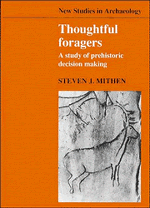Book contents
- Frontmatter
- Contents
- List of figures
- List of tables
- Preface
- 1 Introduction
- PART ONE LEARNING FROM THE PRESENT
- PART TWO MESOLITHIC FORAGING AND SOCIETY
- 4 Broken bones and buried bodies: patterns in the archaeological record
- 5 Gearing up with methodological tools: building a simulation model
- 6 Decision making in the Mesolithic: multiple action replays
- PART THREE UPPER PALAEOLITHIC ART AND ECONOMY
- Bibliography
- Index
6 - Decision making in the Mesolithic: multiple action replays
Published online by Cambridge University Press: 04 August 2010
- Frontmatter
- Contents
- List of figures
- List of tables
- Preface
- 1 Introduction
- PART ONE LEARNING FROM THE PRESENT
- PART TWO MESOLITHIC FORAGING AND SOCIETY
- 4 Broken bones and buried bodies: patterns in the archaeological record
- 5 Gearing up with methodological tools: building a simulation model
- 6 Decision making in the Mesolithic: multiple action replays
- PART THREE UPPER PALAEOLITHIC ART AND ECONOMY
- Bibliography
- Index
Summary
Only connect! That was the whole of her sermon.
Only connect the prose and the passion, and both will be exalted, and human love will be seen at its highest.
E.M. Forster, Howards EndThe echo in a Marabar cave … is entirely devoid of distinction … Hope, politeness, the blowing of a nose, the squeak of a bat, all produce ‘bourn’.
E.M. Forster, A Passage to IndiaNow comes the crunch – to make a connection between the simulated archaeological record, i.e. the faunal assemblages generated by the computer model, and the real world. I'm not sure which of these might be termed the prose and which the passion but certainly if a connection is made the value of both will be exalted! This connection must, however, be meaningful. To show that the computer model can produce patterning which is similar to that in real assemblages is insufficient in itself. Many very different models may produce patterns which cannot be distinguished between – like the echoes in a Marabar cave – and all of which may bear a resemblance to the real data. This is the problem of equiflnality, which haunts those using simulation and has scared some away. Similarly, we can never be absolutely sure that patterns in faunal assemblages are not purely the result of preservation and excavation. My solution to these problems is that we must examine whether the model producing the simulated pattern, and in this case the type of decision making that is implied, is useful for explaining other aspects of the same archaeological record which initially appear unconnected with faunal assemblages.
Information
- Type
- Chapter
- Information
- Thoughtful ForagersA Study of Prehistoric Decision Making, pp. 152 - 194Publisher: Cambridge University PressPrint publication year: 1990
